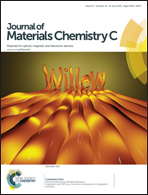Second-harmonic generation (SHG) and photoluminescence properties of noncentrosymmetric (NCS) layered perovskite solid solutions, CsBi1−xEuxNb2O7 (x = 0, 0.1, and 0.2)†
Abstract
Solid solutions of noncentrosymmetric (NCS) Dion–Jacobson phases, CsBi1−xEuxNb2O7 (x = 0, 0.1, and 0.2), have been synthesized through standard solid-state reactions. Powder X-ray diffraction analysis suggests that the solid solutions crystallize in the NCS polar orthorhombic space group, P21am (no. 26). CsBi1−xEuxNb2O7 reveal layered perovskite structures that are composed of corner-shared distorted NbO6 octahedra and the stereoactive A-cation, Bi3+. Powder second-harmonic generation (SHG) measurements of the reported materials show that CsBiNb2O7, CsBi0.9Eu0.1Nb2O7, and CsBi0.8Eu0.2Nb2O7 possess SHG efficiencies 50, 30, and 25 times that of α-SiO2, respectively. The decrease in the SHG for Eu3+-doped compounds is attributable to the deficiency of the net moment generated from the polyhedra of the polarizable lone pair cation, Bi3+. The stronger electric dipole transition bands compared to those of the magnetic dipole transitions in the photoluminescence emission spectra of CsBi1−xEuxNb2O7 confirm the asymmetric coordination environment of Bi3+/Eu3+ sites in the framework.


 Please wait while we load your content...
Please wait while we load your content...